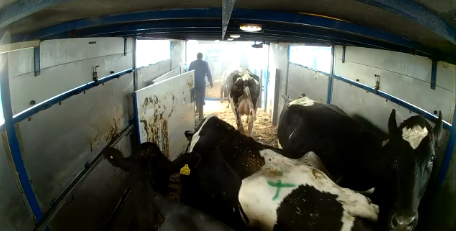New knowledge about transport of cull cows to slaughter
Transport of dairy cows to slaughter may result in deterioration of their clinical condition. New research from the Department of Animal Science, Aarhus University, may play a part in improving animal welfare during transport and contribute to the debate about the concept of fitness for transport.
![[Translate to English:] Køer i forsøget under transport. Foto: Kirstin Dahl-Pedersen. [Translate to English:] Køer i forsøget under transport. Foto: Kirstin Dahl-Pedersen.](/fileadmin/news_import/Under_transport_red.jpg)
Every year, approximately 200,000 dairy cows are slaughtered in Denmark. The cull cows are typically transported to slaughter by truck. Cull cows may have various disorders or weaknesses, and knowledge of these issues is important for being able to assess whether the cows are fit for transport and for optimizing animal welfare during transport to the slaughterhouse.
Researchers from Department of Animal Science, Aarhus University, have observed 411 cull cows from Danish dairy herds on their way to slaughter. On average, the cows were transported 129 km, varying from 20 to 339 km. The journeys lasted between 30 minutes and 8 hours.
Deterioration during transport
All cows were thoroughly examined before being loaded onto the truck and again immediately after unloading at the slaughterhouse. The clinical examinations focused on lameness, wounds, milk leakage and the cows’ general condition.
Based on existing legislation, all cows were fit for transport before the transport, and 2% (nine cows) arrived at the slaughterhouse in a condition which would have been assessed as unfit for transport (all of them due to lameness). Furthermore, the researchers found a deterioration of the cows’ condition for a number of clinical signs. One-fifth of the cows had become lame or more lame during transport, and there were more lame cows after transport (41%) than before (31%). There were more cows leaking milk after transport (17%) than before (1%), and, finally, the occurrence of wounds was higher after transport (34%) than before (22%).

Unloading of cows in the study. Photo: Kirstin Dahl-Pedersen.
Even though this study did not focus directly on the concept of fitness for transport, the results show that 2% of the cows experienced a deterioration of their condition, resulting in them not being able to meet the requirement of “being able to walk unassisted”. Furthermore, the results suggested a general deterioration during transport. In the European Regulation for transport of animals, it is stated that “all animals shall be transported in conditions guaranteed not to cause them injury or unnecessary suffering” (Transport Regulation, EU 1/2005). However, the text does not specify limits for “injury”, which makes it difficult to determine whether or not the deterioration of the condition of the cows in this study was inconsistent with EU’s regulations on animal transport.
“Our results highlight the need for more knowledge about the concept of fitness for transport and for further studies of the importance of transport for the welfare of cull cows, including development of methods on how to improve transport of cattle,” says senior scientist Mette S. Herskin, Department of Animal Science, Aarhus University.
Results may contribute to the optimization of animal welfare
The researchers identified a number of risk factors for deterioration of lameness and milk leakage. The risk of deterioration of lameness was higher in cows with low body condition scores, in cows with the hoof disorder digital dermatitis and in cows with pelvic asymmetry. The risk of milk leakage after transport was higher in cows less than 100 days after calving and in case of a long distance to the slaughterhouse.
“The results from the study give farmers and drivers the opportunity to take special care of the most vulnerable cows during transport and thereby ensure their welfare in the best possible way,” says senior scientist Peter Thomsen, Department of Animal Science, Aarhus University.
The article is based on the following two scientific articles:
A descriptive study of the clinical condition of cull dairy cows before transport to slaughter
Further information
Mette S. Herskin, Department of Animal Science, Aarhus University
E-mail: MetteS.Herskin@anis.au.dk
Peter T. Thomsen, Department of Animal Science, Aarhus University
E-mail: ptt@anis.au.dk
